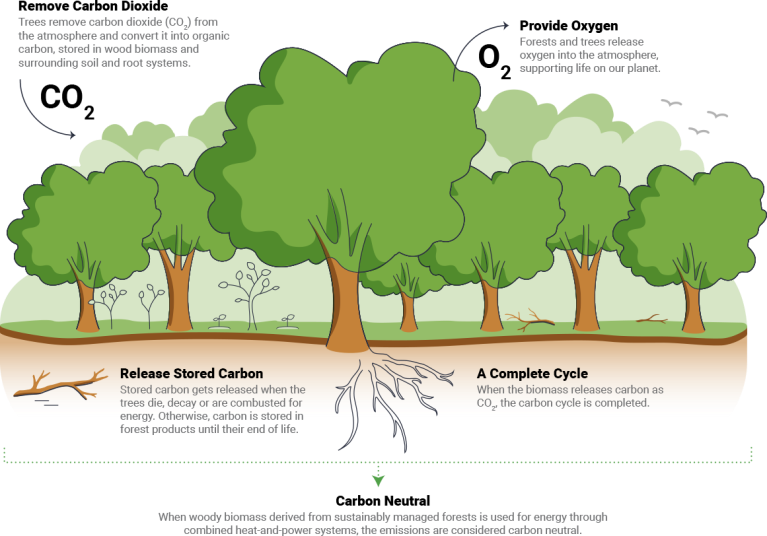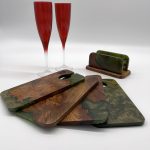For those who have come across DAMA Designs, you will know that a notable feature of our products is the inclusion of resin into the pieces we create. Occasionally, someone might ask about the sustainability of our furniture and homeware items. It’s a fair question, as we all need to ensure we are doing our bit to ensure we leave the planet in a fit state for the generations to come. So what follows aims to answer the question: how sustainable is DAMA Designs wood and resin furniture? There’s some science and chemistry involved, but I promise it’s easy to follow!
Let’s talk about wood
Carbon Capture & Storage
Wood is an interesting material beyond its aesthetically pleasing appearance when fashioned into a thoughtful piece of furniture. We know from our school science days that trees are good at absorbing C02 from the atmosphere and producing life-giving oxygen. In fact, for every cubic meter of wood used in making furniture 1 tonne of harmful C02 is locked in! That means until the end of its physical life (when it rots or is burnt), the wood we use for furniture has a positive effect on the environment.

Sustainably Grown Wood
“But surely felling trees has the potential to damage the environment!” I hear you say? Yes, there’s truth in that, unless it is done in a sustainable way by, replacing what’s been taken by replanting and proper forest husbandry. Thankfully, we are pretty good at that in the UK!
Wood and DAMA Designs
That’s the wood science done. So what does this mean for when it comes to the wood we use for DAMA Designs furniture and homewares? At DAMA Designs:
- We use wood sustainably grown and harvested hardwoods such as oak, elm and ash.
- We buy locally, mainly from wood yards where the wood is grown or harvested in the UK.
- We use wood that would traditionally have found its way into biomass incinerators and commercial ovens – the burning of wood produces harmful C02
- The C02 locked into our wooden furniture has a positive impact on the environment – every cubic meter we use prevents 1 tonne of C02




Hang on, so what about the resin?
Resin and other Polymers
Just a little more science but this time it’s a bit of chemistry! Unless you have studied chemistry – like I did at university – the very thought of a conversation about polymers is enough to have most reaching for the phone to see what’s the latest Instagram post or Facebook message. So I’ll keep it brief!
Epoxy resin (to give it its proper name) is made by mixing resin (a) with a hardener which is sometimes called a ‘curing agent’ (b) and the result is a liquid that turns into an inert hard solid free from harmful VOCs (Volatile Organic Compounds). This resultant solid is called a polymer (c) and this is the process and material we use with wood to create our one-of-a-kind pieces of contemporary furniture and homewares.

OK, but is resin sustainable?
Let’s start by addressing the elephant in the room. Is resin a plastic? Technically yes, as the word plastic is derived from the Greek word plastikos – the term given to a material that is “capable of being shaped or moulded”. Most modern plastics are made from fossil fuel-based compounds but not all, some are now being made from corn and cotton. Resin is a thermosetting polymer (plastic) that requires the chemical reaction described above to produce it. It is different to many other plastics we are familiar with which are known as thermoplastics (e.g. throw away plastic straws, cups and the like).
Many people are unaware that epoxy resin is used in an incredibly wide range of applications, some of which help to reduce C02 emissions:
Renewable Energy Applications (e.g. wind and solar)
Building and construction (e.g. paints, coatings, flooring, adhesives)
Automotive (e.g. primer and top coats)
Food Packaging (e.g. metal drinks cans and lids)
Sports and Leisure (e.g. tennis rackets, skis, golf equipment, fishing rods, kayaks and bicycles)
Aerospace (e.g. aircraft and satellite systems)
Arts and crafts (e.g. paintings, jewellery, castings, photos and pictures)
As can be seen from the list above, epoxy resin, unlike single use plastics (e.g. straws, plastic knives and forks, plastic bags and Styrofoam takeaway containers), has a long life-span and in many instances can be recycled, reused and re-loved. So, is resin sustainable? We believe it is, particularly when blended with wood in the way we use it. However, the science is evolving all the time and as new and improved eco-friendly epoxy resins come onto the market, we will find ways to include them into our designs.
Resin and DAMA Designs
By incorporating resin into our furniture designs, we are able to find new uses for wood that would traditionally have found its way to biomass incinerators, commercial ovens and in so doing, would have released the amount of harmful C02 into the environment.
Our furniture and homeware products are designed to give a lifetime or more of enjoyment and use (rather than through away ‘single use’ items which clog up landfill sites).
Where we can, we try to limit the amount of resin we use. We might introduce it as an accent colour to complement a contemporary piece of furniture or homeware, or use it as a heat protective layer on our ottoman trays.





